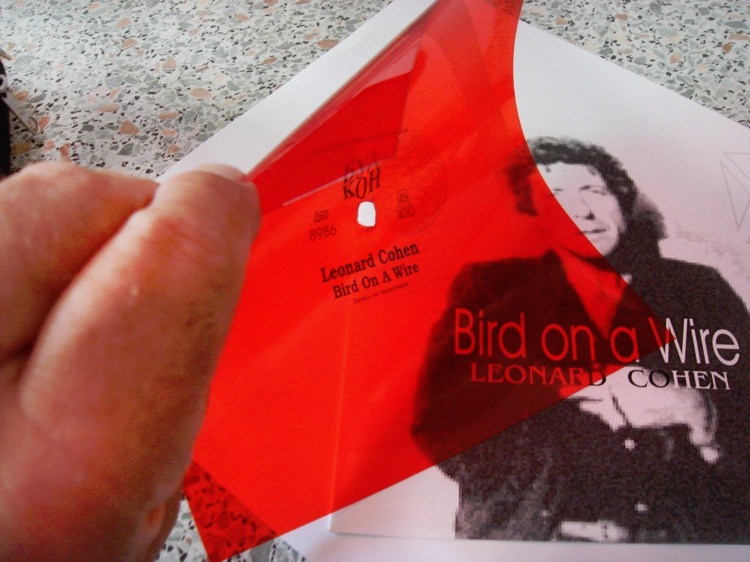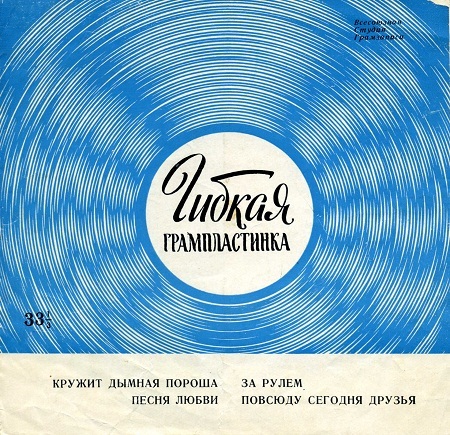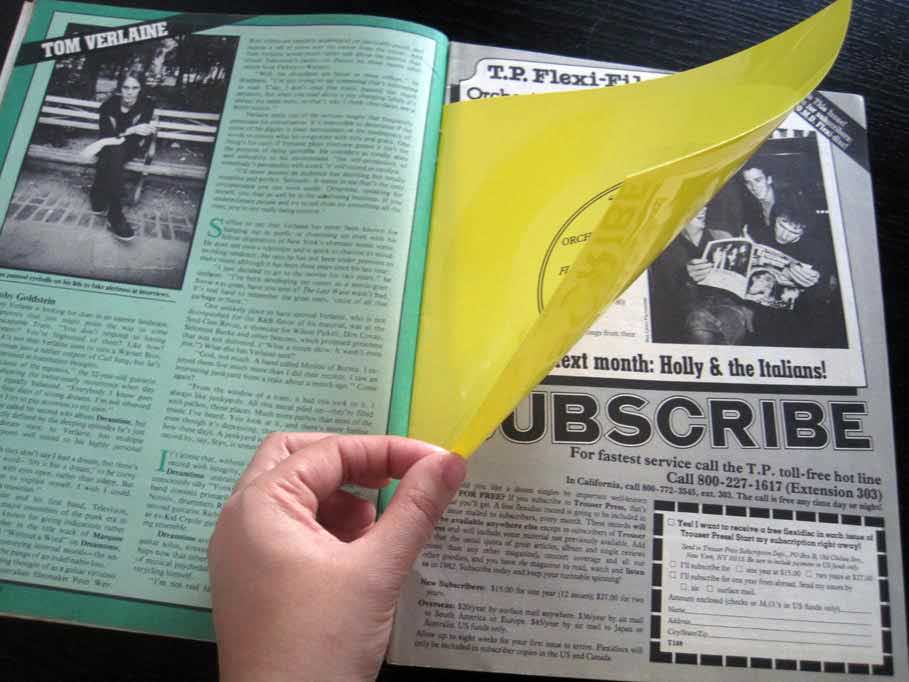Forgotten audio formats: floppy disks

Floppy disks have a surprisingly varied history for such a thin format, and in this article all have merged on their background - from the Beatles, David Bowie and ABBA to Alice Cooper and heavy metal style. Their appearance is associated with the magazine National Geographic, with a million-dollar advertising campaign McDonald's, and with the covers of numerous fashion magazines for girls. They were illegally pressed on x-rays in the USSR [the famous "music on the bones" - approx. transl.] and they even helped such a flagrant liar like Richard Tricky Dicky Nixon to become president of the United States in 1968.
Floppy disks from the 1960s to the early 1990s were sold in tens of millions - and then almost disappeared from the face of the earth for a decade and a half. But, as befits a product based on a spiral scratch, this was not the end.

Leonard Cohen floppy disk. On the outer edge you can see a dark audio track.
')
“Musical postcards” of another kind — coarse grooves pressed into cards — have been sold since about the 1950s. In the second half of the 1950s, even flexible vinyl disks appeared in Britain, although from a technical point of view their quality was disgusting. A few years later, an improved floppy disk was developed, patented, and introduced — the American company Eva-Tone Incorporated released it in 1962, initially naming it the “Eva-tone Soundsheet”. This offspring had several advantages over its parents — the singing postcard and the original spiral groove product, known as a vinyl record.
Eva-tone's soundsheet sounded better than cardboard cards, and since floppy disks used much less vinyl than records, they were much cheaper to print, store and transport. Often in the manufacture of used polyvinyl chloride instead of granulated vinyl, which was even cheaper. In addition, the flexibility of these products meant that they could be sold on covers or inside magazines, booklets and newspapers. They were quite hardy, unlike the 78 rpm shellac disks, which were easily broken if dropped on the floor, or 45 rpm vinyl records, which, although stronger than shellac, could still break by accident.
One little problem
The situation was similar to a comprehensive win, but Eva-tone floppy disks, like their British predecessors, still had a couple of drawbacks. For example, 12 ”or 10” LPs were difficult to make, since floppy disks were very light: a typical single disc or EP weighed usually between 4.5 and 6.5 g - like a pair of sugar cubes. Paper or cardboard packaging weighed more, about 9 g. Compare this with 40 g of a typical vinyl single, or 200 g of many shellac singles at 78 rpm - and you realize how much material was saved.
Then they had a playback problem, when the heavy playhead could simply hold the floppy in place. Under normal conditions, there were two ways out of this situation - you could play a floppy disk, put it on top of a vinyl disc, or put a couple of coins in the area of the disc center. Later, some Soundsheet wheels actually came out with painted circles that indicated where to put the coins. Sometimes you had to perform both tricks at the same time to make the record play.

In the USSR, too, it was
But there were two more intractable problems with new ultrathin recordings. First, although after several first plays for not particularly pretentious ears, the quality of the record could be argued with standard vinyl, floppy disks never had the same frequency range as the full 45-p / m disks or 7.5-inch magnetic tape in coils A professional use of them, for example, on the radio, was possible only if there were no other options.Another annoying factor was the short life of the floppy disks - their shallow pressed tracks led to an increase in surface noise, scratches appearing vivo Recording faster and louder, so skip a track and jumping needle is quickly becoming a major problem drive, losing a few times.
Starry moments floppy disk history
For these reasons, the use of the Soundsheet was quickly limited to three, albeit vast, areas: musical recordings, children's recordings, and advertisements in magazines — mostly, though not always, these magazines were music.
A typical example is The Beatles floppy disk, which they sent to their fan club in 1964. In the video below you can hear such funny things as the track “sing with us” and appeals to fans.
The magnificent four made it again in 1967, although the presentation this time was less ironic and more hasty, but this time there was at least a full-fledged song.
A year later, Richard Nixon won the 1968 election thanks to a well-funded campaign that used the Soundsheet among other materials. More than a million discs were sent to voters in key states, with the mark “Nixon is the one we need!” And with the recording of his speech.
But the wheels were cheap and fun, and sales did not subside until the late 1960s. Promotional recordings from the early 1970s show how large-scale the floppy drive industry has become. The disk on the video below is made in the form of a rectangular sheet, and this form was preserved almost to the very end. In the USA, the term “sound sheet” [soundsheet] has always been more popular than “flexi disc].

Examples of greeting cards on disks. The material itself is a plastic film, which was laminated onto a printed card using lamination.
In Britain, companies producing vinyl, for example Lyntone, bought a license to manufacture improved floppy disks from Eva-tone and preferred the more descriptive term “flexi disc” because the word “disc” was thought to underline the connection to vinyl records. , and the original name from the USA “sound sheet” could confuse music lovers - they might have thought that it was about printed sheet music. Surely the people involved in the industry got angry at the old music-hall joke: “Do you like sheet music? "No, I just like the good stuff ..." ["- Do you like musical music? - No, I prefer good." The joke is based on the consonance of the words sheet and shit - approx. transl.]
David Bowie greatly benefited from the new-format discs when his breakthrough album “The Rise and Falls of Ziggy Stardust and The Spiders From Mars” became one of the fastest growing albums in the summer of 1972. RCA records, with which he was collaborating at the time, was worried that she might not have enough vinyl because of the huge demand — in those years, quick sales of millions of copies were something out of the ordinary — and as a result windy teenage pop fans they will want to wait a couple of weeks for the new batch to arrive and buy something else. Perhaps this fear was not unfounded. And then RCA Records used Dynaflex discs to print tens of thousands of copies of Ziggy Stardust songs using a thin vinyl sheet that outperformed floppy disks, but weighed 25% less than a regular album.
RCA Records managed to release the necessary number of discs, Ziggy remained in the album charts, it soon practically settled in the first places and David Bowie became a true star.
We cut down spending and attack burgers
Some vinyl experts resented this RCA approach. But after the onset of the 1973 oil crisis and the rise in cost of vinyl, such discs for recording companies became a good way to save on the cost of the album, reducing its weight and, as a result, sound quality. The thicker and heavier the album, the better the audio is played - hence the mod among fans of audio on discs from 160 to 200 grams.
Around that time, the leading British newspaper devoted to music, New Musical Express, issued an exclusive recording of Alice Cooper, a good imitation of Elvis Presley called “Slick Black Limousine”. On the reverse side were excerpts from his future album “Billion Dollar Babies”. This edition was highly valued among Cooper fans for many decades, until the record began to appear on pirated discs.

ABBA's Swedish pop sensation also didn’t refuse to give away exclusive distribution: on one-sided “ABBA / Live 77” floppy disk of golden color there are excerpts from their Australian tour of that year. It was distributed only as gifts for children who sold books, newspapers and magazines for the Jultidningsförlaget corporation from house to house on Christmas holidays. And at the other end of the pop culture spectrum in 1978 was the pioneering British electronic band The Human League, distributing a floppy called “Flexi Disc” with a 12 ”single“ Dignity of Labor ”, although it was later reissued on the album“ Reproduction ”. At that time, this group was considered art-house, and in full accordance with their image on this record, one could hear how the members of the group actually discuss floppy disks and whether they should write such a disc themselves.
Meanwhile, in the United States in the 80s, McDonald’s used floppy disks — and in some states cardboard records — to distribute a remake of the stupid but sweet hit "Life Is A Rock (but The Radio Rolled Me)" of 1974 for its Menu Campaign advertising, including instant winnings of $ 1,000,000.
The campaign was incredibly successful and stretched over the years 1988 and 1989. Several different versions of this song were recorded and printed on 78 million (!) Floppy disks, which were then packaged in newspapers and advertising booklets. On each of the recordings there was a voice of some invited singer or just a person from the crowd who tried to perform the song - after his mistake the track ended. McDonald’s acted in a cunning way, printing a single disc on which the song ended correctly. The owner of this single entry had to win a million dollars. After many months of waiting, during which cynics loudly doubted the reality of such a disc, Charlene Price from Galax, West Virginia, found him, who immediately realized the dream of many people: she bought a shop where she worked as a saleswoman. Whether she fired the former boss on the spot, the story is silent ...
In London in the 1980s there was even a separate magazine dedicated to floppy disks. It was called Flexi Pop, and was almost entirely devoted to all kinds of rumors and gossip, and the magazine included a disc with a recording of the song, which was at the top of the charts at that time. Among these candidates were The Jam, Japan and Depeche Mode, and at the peak of popularity, the magazine sold 90,000 copies. Recently even wrote a book about the magazine.
CD killed a floppy star
It seemed that floppy disks would sell better and be distributed more and more often, but the end of the 80s was the beginning of their end. Then there were CDs, and they gradually began to gain popularity as a means to listen to music, and people with limited finances switched to pirated audio tapes - despite the fact that many of these tapes were chrome or metal, and their quality was relatively high. Flexi Pop magazine was closed, and the factories where the discs were pressed, increasingly refused to accept low-cost orders.
Only in the USSR did floppy disks remain in mass circulation until the 1990s, and mostly popular and children's songs were recorded on them. And in the 70s - 80s, when Western rock music was banned in the USSR, pirates and fans illegally recorded audio on X-ray film [ in fact, "music on the bones" existed since the late 40s and until the early 80s, when tape recorders began to appear - approx. trans.].

Relatively new magazine Electronic Sound with a flexible plate inside
With the advent of Mikhail Gorbachev, cultural and political censorship ended, and the music on the bones lost its appeal. By 1992, floppy disks were on the verge of extinction. For nearly 15 years, they remained dead rather than alive. By the year 2000, even Eva-tone had finished their production. But in 2010 there was a small renaissance: the independent factory Pirates Press occupied the niche of vintage products and began to produce floppy disks of all shapes, sizes and colors.
This idea could not be successful, but the magazine of extreme metal, Decibel, has already begun to experiment with this form of recording, releasing exclusive tracks of new groups, and each issue of it actively diverges. Since then, many music publishers, for example, Third Man, Side One Dummy and Domino, as well as Alternative Press magazines and the German PUNKROCK, regularly sell or distribute floppy disks. In 2015, the Italian factory PizzaDischi began to accept orders for the production of such discs, while the cost of rare collectible editions of old floppy disks began to pass for £ 200.
Nowadays, the popularity of floppy disks can be as small as their weight - but it seems that it still keeps afloat. Floppy disks are a rare example of a forgotten audio format that has not completely disappeared and is not completely forgotten.
Source: https://habr.com/ru/post/370421/
All Articles